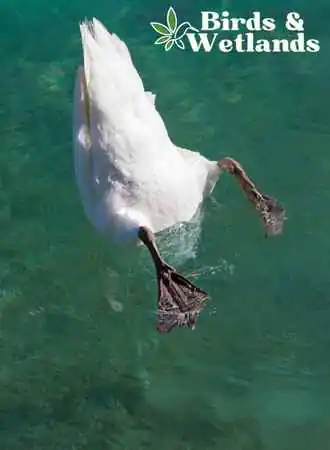A gill, made up of thin membranes filled with capillaries, is an organ in aquatic animals that helps them absorb oxygen and release carbon dioxide into the environment. This organ allows marine animals, fish being the most well-known example, to filter oxygen from the surrounding water to ‘breathe.’
Swans are aquatic animals, so do they have gills?
The answer is no. Swans do not have gills, despite being aquatic birds. They spend most of their time on the water’s surface instead of underwater.
Key Takeaways on Swans
- The swan is a large bird that doesn’t have gills even though it lives in wetland environments.
- Most swans live in cool environments and can be seen feeding in the water.
- Swans have a good breathing system that allows them to fly at high altitudes.
Do swans swim underwater?
Swans such as the trumpeter swan are members of the Anatidae family which includes ducks and geese. These birds build their nest on the ground and prefer to inhabit shallow bodies of water such as freshwater lakes, ponds, and rivers. Other swan species, such as black swans, can be found in marine waters near coasts and estuaries.
Swans such as mute swans do not typically dive underwater as they are not adapted to living in deep water. They are surface feeders using their long necks and mouth to reach down into the water to feed on aquatic plants, small fish and crustaceans. They also use their legs, webbed feet, powerful muscles in their wings and waterproof feathers to help maneuver in the water and lift their tails up when up-ending.
However, the Australian black swan is known to dive underwater occasionally, but only for short periods, typically 10 to 20 seconds. It does this to feed on aquatic plants, roots, and small animals such as snails, insects and crustaceans. This behavior is not common among swans and is only observed occasionally in black swans.

Why do swans dip their head in water?
Swans dip their head in the water to reach and search for aquatic plants, fish, crustaceans, mollusks and invertebrates.
How long can swans hold their breath underwater?
While not all swans dive underwater, most of them dip their heads underwater and can hold their breathe for 10 to 20 seconds.

How do swans breathe?
Swans have highly efficient lungs that allow them to breathe much faster than mammals, including humans. This increased efficiency is linked to the birds’ need for rapid oxygen delivery during flight and their unique lung design.
One key factor in the efficiency of a swan’s lung is tissue density inside the lung. This tissue is much denser than that found in a mammal’s lung, allowing more blood flow and a greater rate of gaseous exchange. This means a swan can extract more oxygen from the air it inhales than a mammal can from an equivalent amount of air.
Another factor in the efficiency of a swan’s lung is the way that air flows through the lung. Air meets a dead end in a mammal’s lung and must flow into and out of the lung along the same path. This can lead to decreased efficiency due to the air becoming stale and needing to be fully oxygenated.
In contrast, a bird’s lung has a unidirectional flow of air, where air entering the lung goes along one path, and air leaving the lung goes along another. This allows for a constant supply of fresh, oxygen-rich air to be delivered to the lungs, increasing efficiency.

Are swans warm or cold blooded?
Swans, like all birds, are warm-blooded animals, also known as endothermic animals. These animals can maintain a constant internal body temperature regardless of the external temperature.
Warm-blooded animals in the animal world can generate their own heat through metabolic processes. This ability allows them to maintain a constant internal body temperature, which is essential for proper bodily function.
As a result, warm-blooded animals can survive in various temperatures and environments, from the Arctic tundra to the African savannah. Humans, dogs, cats, most mammals and some fish are endothermic.
In contrast, cold-blooded animals, also known as ectothermic animals, can’t generate their own heat and instead rely on external sources to regulate their body temperature. The temperature of their background surrounding directly influences their internal body temperature.
Cold-blooded animals are often found in warmer climates and are typically less active in colder temperatures. Most fish, frogs, crocodiles and lizards are examples of ectothermic animals.
Related Questions on Swans
Do male swans have cloaca?
Yes, the male swan possess a cloaca – an internal passage with one opening for disposing of both urine and fecal material.
How long can a swan’s neck reach and what is its flexibility like?
A swan’s neck is flexible and can reach over 40 feet long.

Do females protect their eggs against predators?
Yes, swans are generally known for their aggressive behavior toward any animals or threat that approach their nesting site, regardless whether if its during the day or night. These birds are wary of sounds that can be heard and will investigate what’s happening.
The male is more aggressive than the female. The pair mates for life and is highly protective of their young which is also called cygnets.


